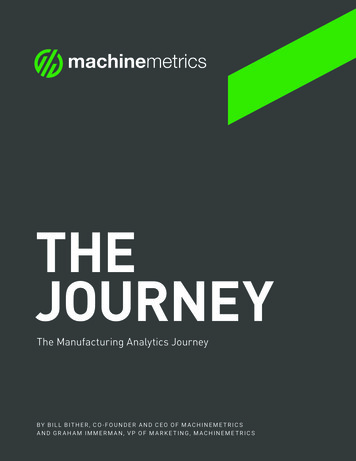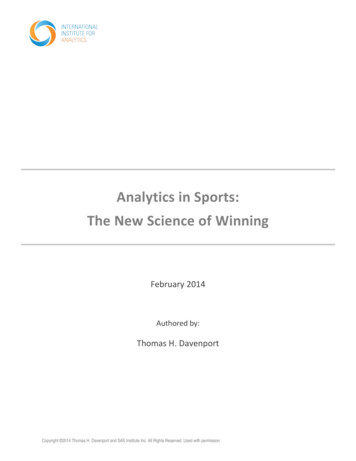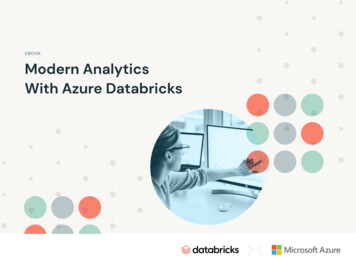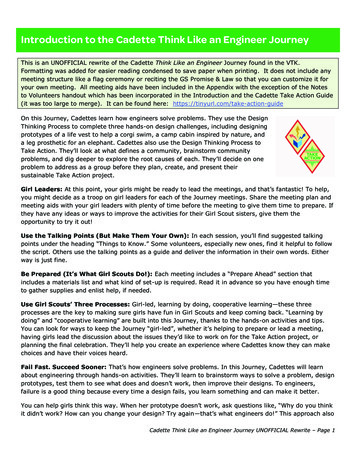
Transcription
THEJOURNEYThe Manufacturing Analytics JourneyBY BILL BITHER, CO-FOUNDER AND CEO OF MACHINEME TRICSAND GR AHAM IMMERMAN, VP OF MARKE TING, MACHINEME TRICS
T H E M A N U FA C T U R I N G A N A LY T I C S J O U R N E YContents—PA R T O N E . . . . . . . . . . . . . . . . . . . . . . . . . . . . . . . . . . . 0 3The Manufacturing Analytics Journey . . . . . . . . . . . . . . . . . . . . 03What Is Manufacturing Analytics? . . . . . . . . . . . . . . . . . . . . . . 03What Are The Advantages of Leveraging Manufacturing Analytics? . . . 04—PA R T T W O . . . . . . . . . . . . . . . . . . . . . . . . . . . . . . . . . . 05From Descriptive to Prescriptive . . . . . . . . . . . . . . . . . . . . . . . 05Descriptive Analytics . . . . . . . . . . . . . . . . . . . . . . . . . . . . . . 06Diagnostic Analytics . . . . . . . . . . . . . . . . . . . . . . . . . . . . . . 08Preventative Analytics . . . . . . . . . . . . . . . . . . . . . . . . . . . . . 09Prescriptive Analytics . . . . . . . . . . . . . . . . . . . . . . . . . . . . . 10—PA R T T H R E E . . . . . . . . . . . . . . . . . . . . . . . . . . . . . . . . 11How Data on Production and Quality Combine to Create Useful Analytics 11Going from descriptive to predictive analytics . . . . . . . . . . . . . . . . 11
T H E M A N U FA C T U R I N G A N A LY T I C S J O U R N E YPart OneT H E M A N U FA C T U R IN GA N A LY T I C S J O U R N E YW H AT I S M A N U FA C T U R IN GA N A LY T I C S?In the past, if you wanted to know how a machinewas performing on a shop floor, you would havehad to put pencil to paper and note the throughput,the error rate, the quality, all manually. You wouldhave to look at the quality of the inputs and theavailable supply of the raw materials. You wouldhave had to look at the throughput over time to seeif there was a consistency to quality or errors thatneeded to be investigated.Analytics is essentially the collection andmanipulation of large quantities of data to revealinsights. In manufacturing, the large quantities ofdata collected come from production equipment,logistics and supply chain management, and shopfloor operators. These data from different sourcesand processes are collected and reformatted aseasy to understand metrics, to reveal where thereare issues with performance or output quality.In other words, you were looking at potentiallyweeks of manual effort to figure out why and how amanufacturing process was going awry. That, in andof itself, isn’t a good use of anyone’s time and is apretty inefficient way to become more profitable.Thus, manufacturing analytics goes beyondthe actual collection of the data to include theformulation of insights that can be used at everylevel of the organization. The advancement of toolsand software in this area means that the process ofcollecting data is no longer manual and the analysisis centrally available, in real-time. This ensuresanalytical insight is available for everyone from theshop floor manager to the CEO to review and, mostimportantly, take action on.Then came Industrial IoT (IIoT) and the ability tomonitor machines directly, providing quantitiesof data from the machine, as well as the operator,that can be analyzed in order to improve bothproduction and quality. According to research, IIoThas the ability to push the manufacturing industry’sproductivity rate and generate approximately 1.2trillion for manufacturers worldwide.03
T H E M A N U FA C T U R I N G A N A LY T I C S J O U R N E YWHAT ARE THE ADVANTAGE S OF LE VER AGING MANUFACTURING ANALY TICS?“Increased revenue (33.1%),increased customer satisfaction(22.1%) and increased productquality (11%) are the top threebenefits of Industrial Analytics.”(Source)THERE ARE MANY ADVANTAGE S TO LE VER AGING RE AL-TIME ANALY TICS:Customer satisfactionThe ability to discover performance and / or qualitycontrol issues in every individual order before theybecome problematic, leads to better customersatisfaction.Availability of real-time dataRather than waiting for a problem, the availabilityof real-time data that is formatted into metrics andinsights constructed for specific users, a problemwith a machine can be proactively discovered, evenpredicted based on historical data and currentusage.Reduction in errorsTracking the Mean Time Between Failures (MTBF),leads to an optimized manufacturing process. WithMTBF, errors that may cause items to be scrappedwill be detected early. Early detection means lessexpenses for the manufacturer.Reduction in unplanned downtimeThe real-time data also allows operators to getan immediate view of the performance of any givenmachine; a minute lag in production or issues thatmay affect quality can be picked up in real-time.This ensures the needed maintenance or repairscan be scheduled to forestall further damage tomachines. Thus, instead of operators existing inreactive mode, they’ll be able to be proactive inhandling the maintenance of machines. Eventually,with the application of artificial intelligence tomachine data and data analytics, AI will enablemachines to fix themselves without humansupervision.Reducing manufacturing costsA data-driven manufacturing process optimizesmachine utilization, enables predictivemaintenance, and improves overall productionefficiency levels. The reduction in scraps, downtime,and maximizing operator schedules lead to hugerecurrent savings for manufacturers.04
T H E M A N U FA C T U R I N G A N A LY T I C S J O U R N E YPart TwoDESCRIPTIVEDIAGNOSTICPREDICTIVEPRESCRIPTIVEWhat is happening?Why is it happening?What is likely to happen?What should I do about it?T H E M A N U FACT U R I N G A N A LY T I C S J O U R N E YF R O M D E S C R I P T I V E TO P R E S C R I P T I V E Descriptive Analytics, which use dataaggregation and data mining to provide insightinto the past. Descriptive analytics answers thequestion; “What has happened in the past” and“What is happening now”Diagnostic Analytics: Diagnostic analyticsattempts to understand and answer thequestion, “Why it happened?” Predictive Analytics, which use statisticalmodels and forecasts techniques to understandthe future. Predictive analysis answers thequestion; “What could happen?” Prescriptive Analytics, which use optimizationand simulation algorithms to advise on possibleoutcomes. Predictive asks the question “Whatshould we do?”05
T H E M A N U FA C T U R I N G A N A LY T I C S J O U R N E YD E S C R I P T I V E A N A LY T I C S U S ECA S E S FO R M A N U FACT U R I N GIn manufacturing, descriptive analytics has multipleuse cases. These cases include; evaluating pastproduction cycles, providing benchmark data,optimizing machine performance, and developing afoundation for diagnostic and predictive analytics.MachineMetrics Operator View allows operators to add humancontext to machine data with a touch screen interface mountedright at the machine tool. Categorize downtime, reject a part,and start/stop jobs to manage and record quality data.D E S C R I P T I V E A N A LY T I C SDescriptive analytics is the interpretation of historicaldata to understand the performance and changesthat have occurred in a business. If you want to knowwhat happened, use descriptive analytics and untilrecently, this is how most companies used data—tosee what had happened in the past.Descriptive analytics provides insight into the pastand showcases the effects of the decisions that weretaken. The analytics can be customized to fit anytime frame or set of customers. If you want to knowwhat has happened in the last 30 days or year withonly a certain demographic of customers, descriptiveanalytics can get you accurate answers.In customer experience, descriptive analytics can beused to track things like total tickets and resolutions.They can be especially helpful in tracking trends tohelp plan for the future. If the number of customercalls increased greatly around the holidays orwhen a new product launched, you can plan forincreased call volume around those events in thefuture. Descriptive analytics can also help provide abetter understanding of customers by tracking theirshopping and contacting preferences.To understand these use cases, the example of amachine shop producing metal components paintsa clearer picture. In this scenario, the machine shopcollected machine and production data through thefirst quarter of 2019 and intends to use the data fordescriptive analytics. With the collected data, themachine shop successfully: Evaluated 2019’s Productivity LevelsWith descriptive analytics, the machine shopwas able to highlight which month was the mostproductive and what made it so. It could also trackdowntime and the causes from the historical data. Benchmark DataThe collected data and the evaluation doneprovides benchmark data highlighting the mostproductive cycle through the months and whyproductivity was optimized. Develop a Foundation for Predictive AnalyticsTo effectively plan for the future, knowledge of thepast is required. The benchmark data descriptiveanalytics provide will be used by the machine shopto estimate machine production capacity, theeffects of increased demand and downtime etc.Descriptive analytics then puts the machine shop ina better position to plan for optimized productivitythroughout 2020. It also provides manufacturerswith insight into the important data that wasoverlooked so solutions can be put in place tocapture them in the future.06
T H E M A N U FA C T U R I N G A N A LY T I C S J O U R N E YT H E I M P O RTA N C E O F B E N C H M A R K DATA FO R D E S C R I P T I V E A N A LY T I C SNo manufacturing service or operation exists in avacuum. Today, the manufacturing industry happensto be one of the most competitive industries outthere. Thus, to compete manufacturers routinelycompare their productivity metrics with those of thecompetition.Benchmark data refers to the optimized industrywide data of a machine needed for thesecomparisons. Thus, with benchmark data, youcan evaluate both current and older machinedata against the benchmark for your machine todetermine or discover production shortfalls.Using benchmark data as a descriptive analytics tool,manufacturers can answer questions such as: Whatdo we do to optimize machine performance to meetindustry standards? What are we doing wrong thatmakes us lag behind the competition?U T I L I Z AT I O N H E AT M A P, A L L C O M PA N I E SSource: The ‘2019 State Of The Industry CNC Machining’ report, MachineMetrics.07
T H E M A N U FA C T U R I N G A N A LY T I C S J O U R N E YD I AG N O S T I C A N A LY T I C SDiagnostic analytics involves the analysis ofhistorical data and real-time data with the aim ofanswering the question ‘Why did this happen andwhy is it happening’. In contrast to descriptiveanalytics, diagnostic analytics is less focusedon what has occurred but rather focused on whysomething happened. In general, this analyticalprocess involves looking at the processes andcauses, instead of the result. Here is an exampleof diagnostic analytics “A machine is workingoptimally for longer durations and the likely reasonis due to the fluid change and servicing activitiesthat were done a week ago.”Thus, diagnostic analytics show that the fluidchange is why the machine is functioning optimally.On the other hand, descriptive analytics willrecord that timely fluid changes lead to increasedperformance. Also, take note that descriptiveanalytics cannot provide an answer to importantquestions such as “How can we avoid this problem”or “How can we duplicate this solution?” These arecovered by diagnostic analytics.D I A G N O S T I C A N A LY T I C S U S EC A S E S F O R M A N U FA C T U R IN GThe manufacturing industry relies heavily ondiagnostic analytics to ensure production cyclesare efficiently run. The application of diagnosticanalytics covers asset maintenance, dealing withdowntime, and also providing a foundation forpredictive and prescriptive analytics.Using the machine shop as an example, the machinedata it collected during a morning shift showed thatits machines broke down regularly during the 3rd shift.Using diagnostic analytics to delve deeper into thedata collected during the durations the alarm rang out,it was discovered that a program was changed theprevious day. These program changes were identifiedas the underlining cause of the failures.View and export real-time machine data and alarms as timeseries data and charts to help diagnose and resolve problems.To eliminate the breakdown that occurred duringthe 3rd shift, the programmer reviewed thecodes from the previous day, debugged it, andcorrectly deployed it. This successfully solvedthe issue and stopped the alarm from ringing.Thus, with diagnostic analytics the machine shopsuccessfully; Discovered CausationCorrelating machine data with historical data,the shop floor carried out diagnostic analysesto know the cause of its problems. Developed SolutionsThe analytics done also provided a basisfor initiating a solution to ease the problemand stop it from re-occurring in the future. Built a Foundation for Predictiveand Prescriptive AnalyticsSuccessfully understood why this ishappening ensures the solution foundcan be applied in the future before abreakdown occurs.08
T H E M A N U FA C T U R I N G A N A LY T I C S J O U R N E Yexample, predictive analytics can be usedto drive production scheduling policies, predictivemaintenance, optimize machine performance,and enhance productivity levels. Develop Future SchedulesWith increased demand comes the needfor increased production activities and onlya few shop floors can switch up their productioncapacity without adequate planning. Thus,predicting future demand enables the creationof schedules that take into account theexpected change in consumer consumption rate. Predictive MaintenanceEquipment breakdown leads to downtime anda less motivated workforce. With predictiveanalytics, unplanned downtime becomesplanned downtime which gives operatorsscheduled time-offs for other plannedactivities. Patterns in the data can indicatethat a component of the machine is beginningto fail. Predicting when that component mightfail means maintenance teams can plan topreventatively fix the problem before it causesunplanned downtime. Enhance Productivity LevelsPredictive analytics provide a basis foradvanced capacity planning which enablesmanufacturers to optimize machine efficiencyand productivity levels.With MachineMetrics Edge platform, you can easily collect andanalyze low and high-frequency machine data to quickly developand deploy predictive analytics algorithms.P R E D I C T I V E A N A LY T I C SPredictive analytics involves the analysis of historicaland real-time data to provide insight into what couldhappen in the future with high-levels of accuracy.With predictive analytics, the future is no longera blank plate and this is made possible throughthe use of data analytics, artificial intelligence,simulation, and machine learning.AI-powered platforms employ machine learningand anomaly detection to analyze large data sets tocreate forecasts for specific months, days or years.The large data sets are collected from businessoperations and assets. The collected data serve asthe basis for predictive analytics.P R E D I C T I V E A N A LY T I C S U S EC A S E S F O R M A N U FA C T U R IN GIn manufacturing, predictive analytics has becomean important concept because of its ability tohelp manufacturers plan for the future. The datasets collected in manufacturing to aid predictiveanalytical initiatives, include real-time machine data,inventory data, data from descriptive and diagnosticanalytics etc. Once collected, predictive analyticscan be initiated and using the machine shop as an09
T H E M A N U FA C T U R I N G A N A LY T I C S J O U R N E YP R E S C R IP T I V E A N A LY T I C S U S EC A S E S F O R M A N U FA C T U R IN GIn manufacturing, prescriptive analytics can be appliedin diverse ways to deliver an optimized productionenvironment and to create customer behavioralmodels that influence decision making processes.A manufacturer can use descriptive data to developmultiple products which will appeal to customersaccording to age demographics or location.Create and manage preventative maintenance schedules inMachineMetrics that are tied to calendar time, usage time,or initiated from machine conditions. Assign maintenancetasks through a workflow.P R E S C R I P T I V E A N A LY T I C SOne of the newest types of data analytics isprescriptive analytics, which takes descriptive,diagnostic, and predictive data and uses it tomake recommendations for future actions andimprovements. Prescriptive analytics give adviceon potential outcomes and recommend what willhappen if those outcomes are reached. By pinpointingthe best outcomes and making recommendations,companies can focus on delivering amazing customerexperiences. Prescriptive analytics help companiesmake decisions that reflect customers’ needs andchanging trends.Some credit card and insurance companies useprescriptive analytics to analyze past factors likepurchase history and credit score, to predict how acustomer will behave in the future and what actionsthe company can take. Prescriptive analytics isaction-based and helps keep the company ahead oftrends to make smart, future-focused decisions.Prescriptive analytics allows lesser skilled workers tobe provided instructions that would normally requirea more experienced higher skilled worker with tribalknowledge. Advances in prescriptive analytics willimprove the skills gap in many industries, includingmanufacturing.This expansion will require an increase in productioncapacity, the need for an updated inventory, andadvanced planning. Using the machine shop asan example, expanding operations to include themachining of complex parts will require differentmaterials and tools. With prescriptive analytics, themachine shop can devise multiple solutions whichtake into consideration capital and equipmentconstraints. The machine shop stakeholders canthen choose the most viable option for expandingtheir operations.In one example, when a machine alarms out, we candeliver instructions to the operator on how to fix theproblem when it occurs. In another example, we candeliver a message to the CNC programmer in real-timethat a program change caused a quality issue, givingthe information to the programmer that recent changeto the program caused an inadvertent issue.ADAPTIVE CONTROLPrescriptive analytics typically involves the humanin the loop to make pro-active change. With controlover the machine, changes can be made directly tothe machine to improve throughput and avoid failures.These features are often built into the machine itself,but with the advent of machine learning, and thebenefit of newer data sets, after-market features canbe developed with this data. For example, machinelearning algorithms can be developed to detectcutting tool wear, and instruct the machine to changethe tool - preventing unplanned downtime, improvingquality, and improving tool life.10
T H E M A N U FA C T U R I N G A N A LY T I C S J O U R N E YPart ThreeH O W DATA O N P R O D U CT I O N A N D Q U A L I T YC O M B I N E TO C R E AT E U S E F U L A N A LY T I C S“69% of decision-makers believe Industrial Analytics will becrucial for business success in 2020, with 15% consideringit crucial today.”(Source)Production and quality are undeniably interrelated.A gain in one that results in a loss in the otheris not moving the manufacturing process, or itsassociated costs, forward. In the past, data onperformance was often looked at separately fromquality. Whether a machine—or their operators—were lagging during the overnight shift set up on abig order was seen as distinct from the quality ofthe output.granular level to be able to predict issues onthe shop floor and save money while improvingoutput, in the process. Taking historical data, forexample, and estimating what isn’t known, suchas future demand, the statistical possibility ofmachine failure and so on will help everyone fromthe operator on the shop floor to the higher-leveldecision-makers to see where production is at orlikely to be, at any given moment.The theory being that the customer would be okaywith a longer production time on their order aslong as the quality was there. But that’s no longerthe case. Customers the world over are expectingmore and rightfully so. To achieve a better levelof satisfaction, the data on performance ANDquality must be combined to achieve industry ororganizational level markers. These metrics arethe difference between keeping a client happy andsimply keeping them.MachineMetrics provide diverse tools thatenable manufacturers to collect shop floor dataand go from descriptive to predictive analyticswhile reaping the accrued benefits. As with anyprediction or estimate, there is no guarantee ofaccuracy, but it’s far more likely to be valid whenenough data is used to support the analytics, thanhuman predictions.G O I N G F R O M D E S C R IP T I V ET O P R E D I C T I V E A N A LY T I C SAll in all, the manufacturing industry is seeing thatdata analytics aren’t just about ‘keeping track ofthings’ but about increasing revenue, reducingcosts and maintaining a level of customer servicethat will keep it relevant in the years to come.The bottom line in manufacturing analytics is to gobeyond the simple collection and display of data(descriptive) to leveraging it at a more11
A BOUT M ACHINEME TRIC SMachineMetrics is manufacturing’s first Industrial IoT Platform for Machines.We transform analytics into action through universal machine connectivity,cloud data Infrastructure, and communication workflows that optimizemachine operation. Right now, hundreds of manufacturers have connectedthousands of machines to MachineMetrics across global factories.Our platform is enabling these companies to deliver the right informationto the right person at the right time to improve their machine performanceand productivity, increase their capacity utilization and ultimately win morebusiness to remain globally competitive.CONTAC T s.com
PREDICTIVE ANALYTICS Predictive analytics involves the analysis of historical and real-time data to provide insight into what could happen in the future with high-levels of accuracy . With predictive analytics, the future is no longer a blank plate and this is made possible through the use of










